| Author |
Message |
MacGyver

Guru

Joined: 12/05/2009
Location: United StatesPosts: 1329 |
| Posted: 02:20am 04 Dec 2011 |
 Copy link to clipboard Copy link to clipboard |
 Print this post |
|
When I moved into my land yacht full time, I noticed that the forced air unit (FAU) manufactured a fire ball about the size of an after-burner flame on a jet. In 5 weeks, it used up 8 gallons of propane gas being run only at night and on a thermostat.
I decided that was too much fuel to suit my taste. It's not that I can't afford it, it's more the idea that it's over-the-top inefficient and downright wasteful. I thought I could do a better job, so I ripped out the unit and made my own.
Mine does not heat the place warm and toasty, rather it takes the chill off and if I want to get really warm and toasty, I put on a coat or an extra blanket. My contraption sits on top of my stove. The galley is right adjacent to my stateroom, so it works out fine in the evening when it gets cold.
Here are some pictures so you can see what I've done:
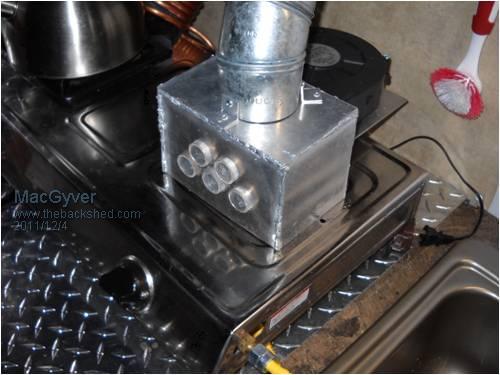
The body is solid aluminum plate. I "welded" the seams where the
1" ID aluminum tubes penetrate the walls. The idea here is it sits atop
a burner on my stove and as much heat as I'd use to make a pot of coffee
heats the tubes inside. I then force air through the tubes into the room.
The exhaust fumes and burning air is sucked to the outside with my
range hood fan.
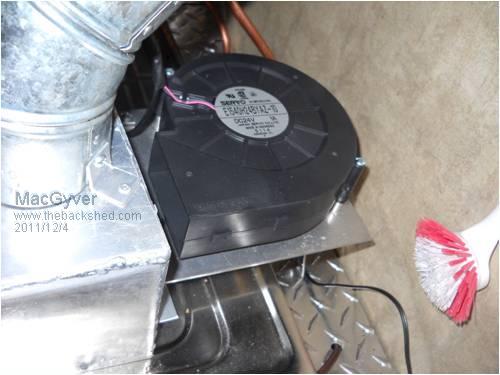
This shows the 12-volt squirel cage fan that drives the air fom the room
through the heated interior of the aluminum tubes.
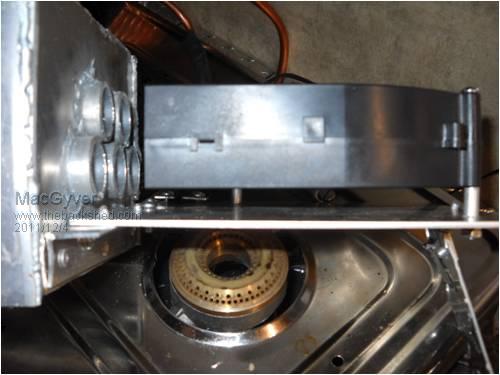
Here's a side shot of that same fan. I used stand-offs to hold the plastic
fan body off the metal surface as well as placed the fan about an inch
from the really-hot tubes. I did this so as not to have any "melt-downs".
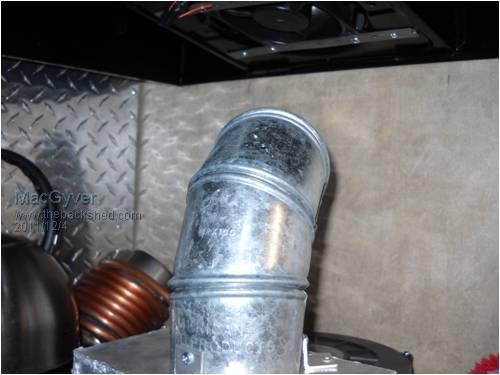
This picture shows the gravity vent atop the unit. Its outlet is aimed at
the range hood's 12-volt fan that takes cooking fumes through the wall
to the atosphere outside.
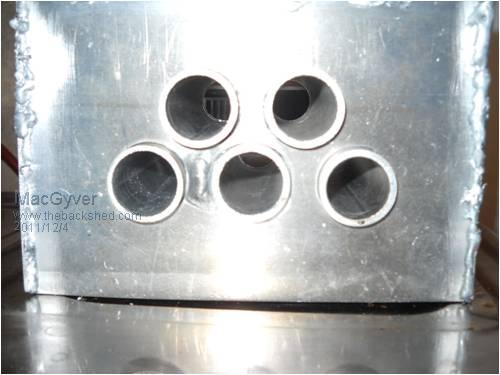
This is a front view of the fire box. The 5 tubes face into the room and
cool room air is forced through them from the fan in the back. This is
what heats my galley and state room. My place is vey small, so this is
actually enough to do the job nicely. My whole living space is less than
200 square feet.
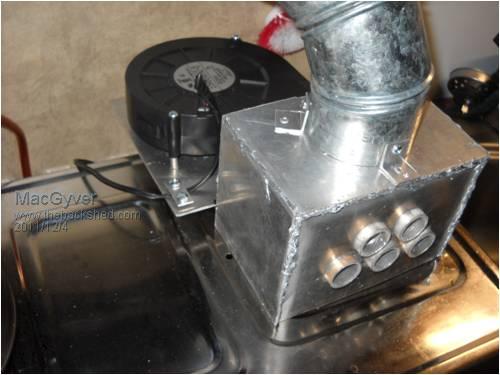
Here's another view showing the fire box, through-tubes and driver fan
at the rear. There is also a post on a hinge used to support the rear side
of the whole thing on the counter top.
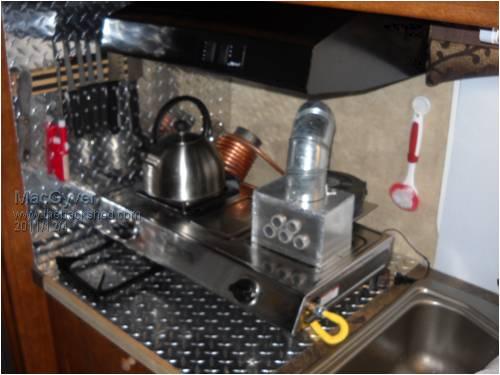
This is my entire galley. That's a two-compartment sink to the right side.
That copper coil in the background is used to top off the water temperature
on days when I have little to no sunshine. It works well, but is unsightly and
I am going to replace it with a welded cylinder closed top and bottom with
an inlet and outlet fitting for the water to pass through. Either merely sits
atop a stove burner and I use propane to augment my electric / solar water
heater's efforts.
I should clarify "welded". What I used is a special type of welding rod that I have used before here on the 4m and explained elsewhere, but I don't remember where, so instead of a link to that thread, I'll just explain it again. This special rod lets you "glue" aluminum to aluminum or any other metal for that matter. On closer examination, it appears only to "stick" stuff together like glue. Think of it as high-temp hot glue and you're right on the money. It works great as long as the two surfaces being joined are extremely clean and free of oil and dust. A fingerprint is too much oil, by the way; it has to be spotless. None the less, these "welds" hold very well both as a seal to hot exhaust gases as well as in a truely "structural" arena. I've used it to attach the pivot tube to small windmills where they sit atop the tower with great success (meaning none have ever broken off yet).
This new FAU will go through an 8 gallon tank of propane just like the former one, but the catch is, it'll take over a year to do so compared to 5 weeks on the former unit.
. . . . . Mac
Nothing difficult is ever easy!
Perhaps better stated in the words of Morgan Freeman,
"Where there is no struggle, there is no progress!"
Copeville, Texas |
| |
Rastus

Guru

Joined: 29/10/2010
Location: AustraliaPosts: 301 |
| Posted: 01:39pm 04 Dec 2011 |
 Copy link to clipboard Copy link to clipboard |
 Print this post |
|
Hi Mac,
You should seriously think of selling the idea to the camping industry.Vans are notoriously cold and the market is world wide!Not to try is more the "idea that its downwright wastefull"Cheers Rastus
see Rastus graduate advise generously |
| |
VK4AYQ
Guru

Joined: 02/12/2009
Location: AustraliaPosts: 2539 |
| Posted: 02:01am 05 Dec 2011 |
 Copy link to clipboard Copy link to clipboard |
 Print this post |
|
Hi Mack
Real Hi Tech mate, shows what you can do with some glue and innovation.
Many years ago when I lived in Victoria I had a similar problem in winter and used a large cast iron pot painted matt black, inverted over the gas burner set to low, it kept the whole van, a 30 foot tri-axle thing liveable in winter, wife decided to put porridge pot on top to cook the morning porridge, that worked OK when she worked out that it needed boiled water in the porridge first. Multi tasking with heat.
All the best
Bob
Foolin Around |
| |
MacGyver

Guru

Joined: 12/05/2009
Location: United StatesPosts: 1329 |
| Posted: 04:44am 05 Dec 2011 |
 Copy link to clipboard Copy link to clipboard |
 Print this post |
|
Bob
That little toy FAU took me all of nearly 3 days to cut and piece together, but after reading your reply, I concocted this little number in about 5 minutes:
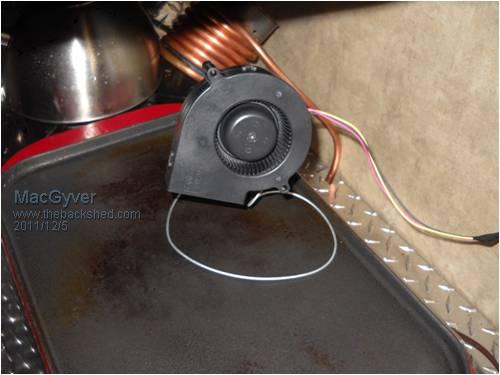
This little 12-volt fan is supported by a wire frame I bent together in
about 4 seconds and the whole rig sits atop my cast iron pancake
griddle. It doesn't deliver as much concentrated heat, but it gets the
job done at about 1/100th the effort.
The wire holds things away from the hot surface enough to keep the plastic fan case from melting while holding the fan in such a position that it gathers cool room air and splashes it against the hot griddle, then sends it out into the room.
Fortunately, I enjoyed all the planning and tinkering of building my more-complicated first try, but for sheer simplicity, you can't beat Bob's idea.
Bob, you're a genius!
. . . . . Mac
Nothing difficult is ever easy!
Perhaps better stated in the words of Morgan Freeman,
"Where there is no struggle, there is no progress!"
Copeville, Texas |
| |
VK4AYQ
Guru

Joined: 02/12/2009
Location: AustraliaPosts: 2539 |
| Posted: 05:29am 05 Dec 2011 |
 Copy link to clipboard Copy link to clipboard |
 Print this post |
|
Hi Mack
The love of inventing and the satisfaction of the unit working is the most important part of any invention, sometimes there is a simpler way to do things, but the satisfaction of doing that way isn't there.
Keep up the innovative work and as Rastus says you may effect the efficiency of heaters in caravans world wide.
All the best
Bob
Foolin Around |
| |

